ESS says they trained all of their executive team how to hear signal correlated noise from dacs (except Martin Mallinson who was unable to learn how). ESS says the human ear is exquisitely sensitive to very low levels of such noise. Some people can hear it without any training. Doesn't sound like resistor noise, it tends to sound like a change in the sound of music; sort of a bright sounding distortion, perceptually speaking.
This is what I listen for as well, an unnatural bright sounding distortion. IMO the conclusions drawn by ESS correlates to studies on temporal coherence. The concept is that human hearing can lock in on, trace, or focus on a particular sound in a sound field as thereupon magnifying its resolution of harmonics, etc. Under circumstances of sounds being electronically amplified this mechanism would also pick up and magnify distortions of alignment or correlation with the source, as to then potentially cause to hear a bright sound if it exists. This appears to some degree as you suggested earlier:
Yes, but the noise is correlated with the audio signal, not purely random. So, it may be audible to some people as excessive brightness, or something like that.
If the intent is to create some form of finally enjoyable system, one being compensated to diminish being overly brighter sounding, this seems would require some means of obscuration of that focus. Yet in doing so can also cause the natural harmonics being diminished along with distortions, seemingly using mechanisms suggested of advantage in this thread.
However, if the object is to advance audio reproduction the adding of obscuration, in whatever manner, doesn't appear advantageous as this would obscure artifacts as resolvable in a decision making process. This is to suggest that it is expected that ESS is using highly transparent sounding equipment following their DAC's to resolve the distortion artifacts they are commenting on in the process of advancing their DAC's.
HQPlayer NOS Signal test
As always, took more time than expected to do this orderly...
No time for text, but the "ones who know" will be able to read this and draw conclusions 😛
I will write to this later today or tomorrow
As always, took more time than expected to do this orderly...
No time for text, but the "ones who know" will be able to read this and draw conclusions 😛
I will write to this later today or tomorrow
Attachments
-
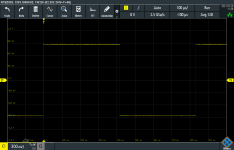 HQ Player NOS Test - Square Wave 1200Hz FS48 - No Filter.png24.5 KB · Views: 291
HQ Player NOS Test - Square Wave 1200Hz FS48 - No Filter.png24.5 KB · Views: 291 -
 HQ Player NOS Test - Square Wave 1200Hz FS48 - IIR Filter.png32.8 KB · Views: 294
HQ Player NOS Test - Square Wave 1200Hz FS48 - IIR Filter.png32.8 KB · Views: 294 -
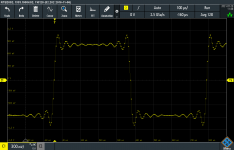 HQ Player NOS Test - Square Wave 1200Hz FS48 - FIR Filter.png31.2 KB · Views: 296
HQ Player NOS Test - Square Wave 1200Hz FS48 - FIR Filter.png31.2 KB · Views: 296 -
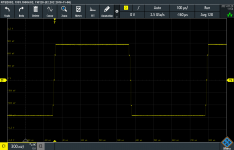 HQ Player NOS Test - Square Wave 1200Hz FS48 - Polynominal-1 Filter.png26.3 KB · Views: 301
HQ Player NOS Test - Square Wave 1200Hz FS48 - Polynominal-1 Filter.png26.3 KB · Views: 301 -
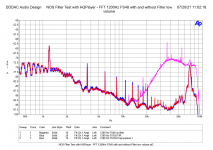 NOS Filter Test with HQPlayer - FFT 1200Hz FS48 with and without Filter low volume.png109.2 KB · Views: 299
NOS Filter Test with HQPlayer - FFT 1200Hz FS48 with and without Filter low volume.png109.2 KB · Views: 299 -
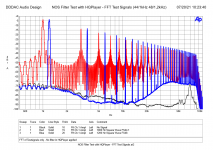 NOS Filter Test with HQPlayer - FFT Test Signals (44-1kHz 48-1,2kHz) - No filter applied in HQP.png136.3 KB · Views: 164
NOS Filter Test with HQPlayer - FFT Test Signals (44-1kHz 48-1,2kHz) - No filter applied in HQP.png136.3 KB · Views: 164 -
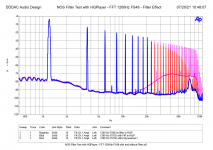 NOS Filter Test with HQPlayer - FFT 1200Hz FS48 - Filter Effect.png91.2 KB · Views: 152
NOS Filter Test with HQPlayer - FFT 1200Hz FS48 - Filter Effect.png91.2 KB · Views: 152 -
 FFT Square Wave 1200Hz with and without HQP Filters.png32.6 KB · Views: 145
FFT Square Wave 1200Hz with and without HQP Filters.png32.6 KB · Views: 145
FIR FILTER ECHO EXPERIMEMT
OBJECTIVE:
The original goal of our investigation was to determine why NOS and OS playback sound characteristically different, when it seems they should not. It now appears that we've found that typical OS interpolation-filters somehow introduce audible artifacts which are responsible for that difference. While it seems we now know which DAC system element is responsible, we haven't identified the root mechanism involved.
BACKGROUND:
This experiment is for the purpose of testing a primary hypothesis for what is the root cause of the characteristic difference in sound between NOS and typical OS playback. This suspect that you will be testing is a phenomena first identified by, R. Lagadec and T.G. Stockham all the way back in in 1984, the early years of CD. They discovered that a type of FIR interpolation-filter design known as an, 'equiripple' filter, produces signal reflections or echoes in the time-domain. These echoes are not to be confused with the familiar impulse-response ringing produced by an FIR filter's SINC functioning.
Such echoes are objectively evidenced by the very low level and repeating frequency-domain ripples which uniformly span an equiripple filter's passband. The echoes are also low level, and not obvious like the echo from shouting in a large room. These ripples are simply the frequency-domain transform of the signal echoes, which themselves exhibit in the time-domain. The ripples are commonly shown within the interpolation-filter performance graphs of many DAC chip data sheets. While Lagadec identified this mechanism many years ago, most DACs chips featuring an OS interpolation-filter continue to be equiripple designs.
This filter echo experiment was conceived and suggested by Marcel. He utilized the 'GoldWave' tool to inject time-domain echoes/response ripples typical of equiripple filters in to some test files. This will enable you to listen to the subjective effect of an increasing degree of injected signal echo. Test files are grouped into sets of triplets for each track title. Each individual file within a set exhibiting one of three levels of injected echo.
INSTRUCTIONS:
Your task, is to listen and rank the three files, which are all 44.1KHz, within each of it's title set according to your subjective preference. From the most preferred file for listening to, down to the least preferred.
In the below link to a publicly accessible Google Drive you will find four folders, each containing a triplet set of files for the same track title. Four titles total, one per folder. Each title set consist of one file which does not feature any injected signal echo, another file which features an intermediate level of injected echo, and a last file which features the greatest level of injected echo. The test ideally utilizes a NOS DAC, because an OS DAC features it's own FIR interpolation-filter which could introduce it's own echo to the test file evaluations.
However, even should you not have access to a NOS DAC, you might still obtain similar results with an OS DAC, as you would an NOS DAC. The difference being, that the base level of echo would be greater, and so Marcel's injected echo may simply sum with that to a greater level for all the files, simply starting from a higher base. In net, producing the same ranking as would a NOS DAC. However, I'm uncertain about this. Should you perform the experiment via an OS DAC, please make that fact very explicit in your results report to Marcel.
Performing this experiment should be as simple as performing our previous experiments, except with the additional factor of choosing among three similar files, instead of between two. Do not overthink your ranking. Simply listen for musical pleasure, and choose whichever rank made your listening of that title the more enjoyable - or, perhaps, the least objectionable 😉. Be warned, that you may find that some files leave you cringing a bit because of the injected echo, just like 'typical' oversampling characteristically may do. Lastly, please don't turn the experiment in to a chore for yourself. We are here to have fun, while we, hopefully, learn something useful to our future listening enjoyment along the way!
Experiment steps:
Step 1) Listen to each file within a given set, and then rank those files in order of your subjective preference for listening pleasure. A = most preferred, B = next preferred, C = least preferred. Please indicate your preference ranking for each file within a given triplet set, with the file number (1, 2 or 3) followed by that file's preference rank.
Random example of a test report:
==================================================
Scarlatti: 1B, 2A, 3C (indicating: file-2 was most prefered, file-3 the least)
Keith Jarrett: 1A, 2C, 3B (indicating: file-1 was most preferred, file-2 the least)
Etc.
==================================================
Step 2) Submit your file rankings to Marcel via PM. He will be scoring the responses, and only he knows which files in each set have the injected signal echo, and which don't.
Echo-Test Files - Google Drive
Thank you, for participating. It will be interesting to see what the results reveal.
OBJECTIVE:
The original goal of our investigation was to determine why NOS and OS playback sound characteristically different, when it seems they should not. It now appears that we've found that typical OS interpolation-filters somehow introduce audible artifacts which are responsible for that difference. While it seems we now know which DAC system element is responsible, we haven't identified the root mechanism involved.
BACKGROUND:
This experiment is for the purpose of testing a primary hypothesis for what is the root cause of the characteristic difference in sound between NOS and typical OS playback. This suspect that you will be testing is a phenomena first identified by, R. Lagadec and T.G. Stockham all the way back in in 1984, the early years of CD. They discovered that a type of FIR interpolation-filter design known as an, 'equiripple' filter, produces signal reflections or echoes in the time-domain. These echoes are not to be confused with the familiar impulse-response ringing produced by an FIR filter's SINC functioning.
Such echoes are objectively evidenced by the very low level and repeating frequency-domain ripples which uniformly span an equiripple filter's passband. The echoes are also low level, and not obvious like the echo from shouting in a large room. These ripples are simply the frequency-domain transform of the signal echoes, which themselves exhibit in the time-domain. The ripples are commonly shown within the interpolation-filter performance graphs of many DAC chip data sheets. While Lagadec identified this mechanism many years ago, most DACs chips featuring an OS interpolation-filter continue to be equiripple designs.
This filter echo experiment was conceived and suggested by Marcel. He utilized the 'GoldWave' tool to inject time-domain echoes/response ripples typical of equiripple filters in to some test files. This will enable you to listen to the subjective effect of an increasing degree of injected signal echo. Test files are grouped into sets of triplets for each track title. Each individual file within a set exhibiting one of three levels of injected echo.
INSTRUCTIONS:
Your task, is to listen and rank the three files, which are all 44.1KHz, within each of it's title set according to your subjective preference. From the most preferred file for listening to, down to the least preferred.
In the below link to a publicly accessible Google Drive you will find four folders, each containing a triplet set of files for the same track title. Four titles total, one per folder. Each title set consist of one file which does not feature any injected signal echo, another file which features an intermediate level of injected echo, and a last file which features the greatest level of injected echo. The test ideally utilizes a NOS DAC, because an OS DAC features it's own FIR interpolation-filter which could introduce it's own echo to the test file evaluations.
However, even should you not have access to a NOS DAC, you might still obtain similar results with an OS DAC, as you would an NOS DAC. The difference being, that the base level of echo would be greater, and so Marcel's injected echo may simply sum with that to a greater level for all the files, simply starting from a higher base. In net, producing the same ranking as would a NOS DAC. However, I'm uncertain about this. Should you perform the experiment via an OS DAC, please make that fact very explicit in your results report to Marcel.
Performing this experiment should be as simple as performing our previous experiments, except with the additional factor of choosing among three similar files, instead of between two. Do not overthink your ranking. Simply listen for musical pleasure, and choose whichever rank made your listening of that title the more enjoyable - or, perhaps, the least objectionable 😉. Be warned, that you may find that some files leave you cringing a bit because of the injected echo, just like 'typical' oversampling characteristically may do. Lastly, please don't turn the experiment in to a chore for yourself. We are here to have fun, while we, hopefully, learn something useful to our future listening enjoyment along the way!
Experiment steps:
Step 1) Listen to each file within a given set, and then rank those files in order of your subjective preference for listening pleasure. A = most preferred, B = next preferred, C = least preferred. Please indicate your preference ranking for each file within a given triplet set, with the file number (1, 2 or 3) followed by that file's preference rank.
Random example of a test report:
==================================================
Scarlatti: 1B, 2A, 3C (indicating: file-2 was most prefered, file-3 the least)
Keith Jarrett: 1A, 2C, 3B (indicating: file-1 was most preferred, file-2 the least)
Etc.
==================================================
Step 2) Submit your file rankings to Marcel via PM. He will be scoring the responses, and only he knows which files in each set have the injected signal echo, and which don't.
Echo-Test Files - Google Drive
Thank you, for participating. It will be interesting to see what the results reveal.
Last edited:
Ken,
You are doing a great Job in motivating everyone to follow you to the absolute bottom of this intriguing theme.
I’m looking forward to see the results of Marcel’s efforts.
Hans
You are doing a great Job in motivating everyone to follow you to the absolute bottom of this intriguing theme.
I’m looking forward to see the results of Marcel’s efforts.
Hans
OBJECTIVE:
They discovered that a type of FIR interpolation-filter design known as an, 'equiripple' filter, produces signal reflections or echoes in the time-domain. These echoes are not to be confused with the familiar impulse-response ringing produced by an FIR filter's SINC functioning.
Hi Ken, no I am really confused.
I thought the convolution of the FIR filter coefficent with the signal samples causes these 'pre(and post) echos' and ultimately results in a SINC function as output when a dirac pulse is fed into it.
What other mechanism are we talking about here?
See pages 49 and 50 and appendix B of https://linearaudio.net/sites/linearaudio.net/files/03 Didden LA V13 mvdg.pdf
Could you tell us the formula for calculating the suppression of pre/post echoes from the passband ripple please?
Where in the chain does the apodizing filter have to sit? Can it be anywhere, i.e. in the PC? Will it control all the rest of the ringing in the recording/playback chain and the passband ripple of the apodizing filter is the only thing that matters then?
Where in the chain does the apodizing filter have to sit? Can it be anywhere, i.e. in the PC? Will it control all the rest of the ringing in the recording/playback chain and the passband ripple of the apodizing filter is the only thing that matters then?
See pages 49 and 50 and appendix B of https://linearaudio.net/sites/linearaudio.net/files/03 Didden LA V13 mvdg.pdf
Also this document talks about pre and post echos that are caused by the impulse response of the FIR filter as far as I know?
(But you know better as you have written it 🙂 )
An ideal low-pass filter with an ultrasonic cut-off frequency would only cause ultrasonic pre- and post-ringing. If you don't believe in the inaudibility of ultrasonics, you can reduce the pre- and post-ringing by inserting a smooth filter somewhere in the signal chain. That's what Peter Craven calls an apodizing filter.
Besides, practical digital filters have imperfections in their passband. Often they are linear-phase filters with passband ripples that are more or less evenly spaced in frequency. According to Lagadec and Stockham, the time domain equivalent of those ripples is a pre-echo and a post-echo. That is, a linear-phase filter with passband ripples more or less behaves as a cascade of a filter with a perfectly flat passband response and a filter having a pre-echo, a main response and a post-echo. That pre- and post-echo affect signals in the passband, so in the normal audible range. There is nothing an apodizing filter can do against them.
As explained in Lagadec and Stockham's 1984 article and in appendix B of my article, a pre- and post-echo of alpha times the main response causes passband ripples of +/- 2 alpha around 1. Expressed in decibel:
A peak-to-peak passband ripple of 20 dB*log10((1 + 2 alpha)/(1 - 2 alpha))
corresponds with
a pre- and postecho of 20 dB*log10(alpha)
The test is meant to check the audibility of pre- and post-echoes, or equivalently passband ripples.
Besides, practical digital filters have imperfections in their passband. Often they are linear-phase filters with passband ripples that are more or less evenly spaced in frequency. According to Lagadec and Stockham, the time domain equivalent of those ripples is a pre-echo and a post-echo. That is, a linear-phase filter with passband ripples more or less behaves as a cascade of a filter with a perfectly flat passband response and a filter having a pre-echo, a main response and a post-echo. That pre- and post-echo affect signals in the passband, so in the normal audible range. There is nothing an apodizing filter can do against them.
As explained in Lagadec and Stockham's 1984 article and in appendix B of my article, a pre- and post-echo of alpha times the main response causes passband ripples of +/- 2 alpha around 1. Expressed in decibel:
A peak-to-peak passband ripple of 20 dB*log10((1 + 2 alpha)/(1 - 2 alpha))
corresponds with
a pre- and postecho of 20 dB*log10(alpha)
The test is meant to check the audibility of pre- and post-echoes, or equivalently passband ripples.
Besides, practical digital filters have imperfections in their passband. Often they are linear-phase filters with passband ripples that are more or less evenly spaced in frequency. According to Lagadec and Stockham, the time domain equivalent of those ripples is a pre-echo and a post-echo. That is, a linear-phase filter with passband ripples more or less behaves as a cascade of a filter with a perfectly flat passband response and a filter having a pre-echo, a main response and a post-echo. That pre- and post-echo affect signals in the passband, so in the normal audible range.
These pre/post echos are generated by the FIR filter and can not extend in time before or after the last/first tap. Right?
Yes, essentially. In my Figure 26 they are smeared out a bit due to the convolution with an ideal sinc, but you see the biggest aberrations just after the first and and just before the last tap.
Last edited:
Ken,
You are doing a great Job in motivating everyone to follow you to the absolute bottom of this intriguing theme.
I’m looking forward to see the results of Marcel’s efforts.
Hans
Thanks, Hans. Welcome back from holiday.
Hi Ken, no I am really confused.
I thought the convolution of the FIR filter coefficent with the signal samples causes these 'pre(and post) echos' and ultimately results in a SINC function as output when a dirac pulse is fed into it.
What other mechanism are we talking about here?
Hi, mvs0,
These signal echoes are a completely different phenomena than is the familiar impulse-response ringing of a FIR filter SINC-function. The ripples we are talking about exhibit in the frequency-domain of the filter's passband, while SINC-function ringing exhibits in the time-domain of the filters transition band. Which, as Marcel mentioned, is ultrasonic. Their mechanisms are completely different.
In addition to Marcel's paper, here is a link to a brief paper (Section 2.0, on pages 2 and 3) by the late Julian Dunn, which also talks about the phenomena we are exploring in this experiment.
https://www.nanophon.com/audio/antialia.pdf
Last edited:
Hi, mvs0,
These signal echoes are a completely different phenomena than is the familiar impulse-response ringing of a FIR filter SINC-function. The ripples we are talking about exhibit in the frequency-domain of the filter's passband, while SINC-function ringing exhibits in the time-domain of the filters transition band. Which, as Marcel mentioned, is ultrasonic. Their mechanisms are completely different.
In addition to Marcel's paper, here is a link to a brief paper (Section 2.0, on pages 2 and 3) by the late Julian Dunn, which also talks about the phenomena we are exploring in this experiment.
https://www.nanophon.com/audio/antialia.pdf
@Marcel: do you agree with this?
A peak-to-peak passband ripple of 20 dB*log10((1 + 2 alpha)/(1 - 2 alpha))
corresponds with
a pre- and postecho of 20 dB*log10(alpha)
The test is meant to check the audibility of pre- and post-echoes, or equivalently passband ripples.
So a passband ripple of 0.002dB corresponds to alpha=5.75e-5?
Code:
0,002dB = 20dB*log10((1 + 2 alpha)/(1 - 2 alpha))
0,0001 = log10((1 + 2 alpha)/(1 - 2 alpha))
1,00023 = (1 + 2 alpha) / (1 - 2 alpha)
1,00023 * (1 - 2 alpha) = 1 + 2 alpha
1,00023 - 2,00046 alpha = 1 + 2 alpha
1,00023 - 1 = 2 alpha + 2,00046 alpha
0,00023 = 4,00046 alpha
alpha = 5,75e-5Sorry my math practice is only slowly picking up speed lately 🙂
@Marcel: do you agree with this?
I agree with the statement that the echoes are related to passband ripple and the sinc ringing to the transition band / to the fact that the filter filters. You can describe both effects in the time as well as in the frequency domain, in fact I just did.
Please join in. All are welcome!
An appeal to all lurkers.
To make clear, if not already, the listening experiments are open for everyone to participate in. I noticed that there are over 50,000 views of the thread, yet we've had at most 7 participants join in one of the experiments. All are welcome, just follow the experiment instructions. We are all in the learning process, so, ask questions should you have them. Your listening report is valuable. The more reports which we obtain, the higher will be the statistical confidence in what they indicate. 🙂
Our current listening experiment:
https://www.diyaudio.com/forums/digital-line-level/371931-makes-nos-sound-105.html#post6727251
An appeal to all lurkers.
To make clear, if not already, the listening experiments are open for everyone to participate in. I noticed that there are over 50,000 views of the thread, yet we've had at most 7 participants join in one of the experiments. All are welcome, just follow the experiment instructions. We are all in the learning process, so, ask questions should you have them. Your listening report is valuable. The more reports which we obtain, the higher will be the statistical confidence in what they indicate. 🙂
Our current listening experiment:
https://www.diyaudio.com/forums/digital-line-level/371931-makes-nos-sound-105.html#post6727251
Last edited:
Thanks, Hans. Welcome back from holiday.
No it’s not over yet, still another two weeks left. 😀 😀
Hans
No it’s not over yet, still another two weeks left. 😀 😀
Hans
I that case, keep enjoying the sunshine and the cool sea breezes. 😛

- Home
- Source & Line
- Digital Line Level
- What do you think makes NOS sound different?